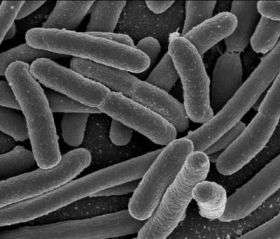New insights on the formation of biofilms could play a role in diminishing antibiotic resistant infections while enhancing the safety of implant materials. Courtesy of Rocky Mountain Laboratories, NIAID, NIH
Researchers in Massachusetts report for the first time that bacteria use a sense of touch in deciding where to form biofilms. Those colonies of microbes grow on medical implants and other devices and play a key role in the multi-billion-dollar-per-year problem of antibiotic resistant infections.
The finding could lead to safer implant materials for fighting biofilms, which are linked to thousands of deaths each year, the scientists say. It also can be used to develop materials capable of sustaining cultures of important, beneficial bacteria. Their study is scheduled for the June 9 issue of ACS’ Biomacromolecules.
In the new report, Krystyn J. Van Vliet and colleagues note that past research focused on killing microbes that already have formed biofilms, or impregnating surfaces with antimicrobial compounds. Scientists knew about certain surface conditions that affected biofilm formation, though many results were in conflict, and the effect of mechanical stiffness of those surfaces had not been considered previously.
The researchers studied the effects of different polymer materials on the adhesion of Staphylococcus epidermidis, the most common bacterial source of hospital-based infections, and on E. coli. In laboratory tests, they found that the bacteria adhered preferentially to the stiffer polymers, as compared to other polymers.
Altering the stiffness of the polymers used in implants could lead to “smarter” materials for fighting or sustaining biofilm formation, they conclude.
Source: ACS
























